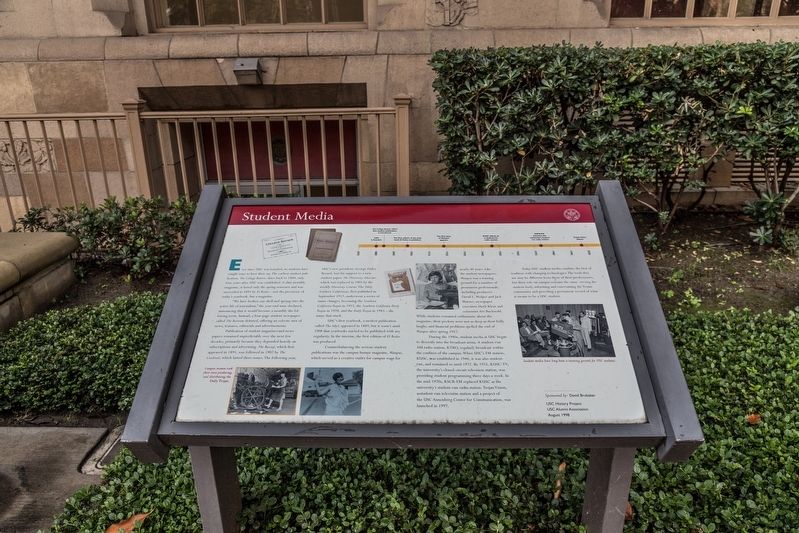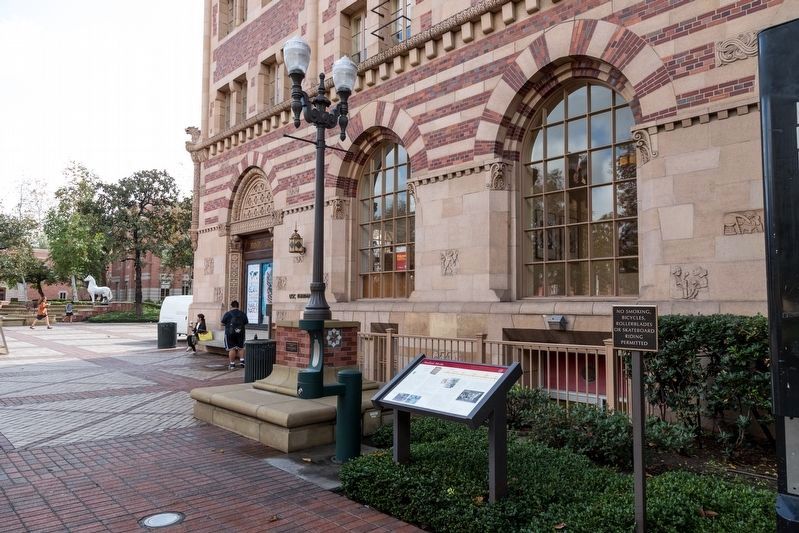South Los Angeles in Los Angeles County, California — The American West (Pacific Coastal)
Student Media
— USC — University of Southern California —
“We have broken our shell and sprung into the active life of journalism,” the year-end issue declared, announcing that it would become a monthly the following term. Instead, a four-page student newspaper called The Rostrum debuted, offering an eclectic mix of news, features, editorials and advertisements.
Publication of student magazines and newspapers remained unpredictable over the next few decades, primarily because they depended heavily on subscriptions and advertising. The Record, which first appeared in 1895, was followed in 1902 by The Cardinal, which lasted three issues. The following year, USC’s new president, George Finley Bovard, lent his support to a new student paper, The University Advocate, which was replaced in 1905 by the weekly University Courier. The Daily Southern Californian, first published in September 1912, underwent a series of name changes, becoming the Southern California Trojan in 1915, the Southern California Daily Trojan in 1928, and the Daily Trojan in 1943—the name that stuck.
USC’s first yearbook, a modest publication called The Sibyl, appeared in 1889, but it wasn’t until 1908 that yearbooks started to be published with any regularity. In the interim, the first edition of El Rodeo was produced.
Counterbalancing the serious student publications was the campus humor magazine, Wampus, which served as a creative outlet for campus wags for nearly 40 years. Like the student newspapers, Wampus was a training ground for a number of prominent professionals, including producers David L. Wolper and Jack Warner, newspaper executive Herb Klein and columnist Art Buchwald. While students remained enthusiastic about the magazine, their pockets were not as deep as their belly laughs, and financial problems spelled the end of Wampus after spring 1957.
During the 1940s, student media at USC began to diversify into the broadcast arena. A student-run AM radio station, KTRO, regularly broadcast within the confines of the campus. When USC’s FM station, KUSC, was established in 1946, it was also student-run, and remained so until 1972. By 1955, KUSC-TV, the university’s closed-circuit television station, was providing student programming three days a week. In
the mid-1970s, KSCR-FM replaced KUSC as the university’s student-run radio station. Trojan Vision, a student-run television station and a project of
the USC Annenberg Center for Communication, was launched in 1997.
Today USC student media combine the best of tradition with changing technologies. The tools they use may be different from those of their predecessors, but their role on campus remains the same: serving the student body, informing and entertaining the Trojan community and providing a permanent record of what it means to be a USC student.
Erected 1998 by USC History Project, USC General Alumni Association. Sponsored by David Brubaker.
Topics. This historical marker is listed in these topic lists: Communications • Education • Entertainment. A significant historical month for this entry is September 1912.
Location. 34° 1.22′ N, 118° 17.132′ W. Marker is in Los Angeles, California, in Los Angeles County. It is in South Los Angeles. Marker is at the intersection of Childs Way and Trousdale Parkway, on the left when traveling west on Childs Way. It is at the Student Union building, at the stairway to the USC Pharmacy. Touch for map. Marker is at or near this postal address: 3601 Trousdale Pkwy, Los Angeles CA 90089, United States of America. Touch for directions.
Other nearby markers. At least 8 other markers are within walking distance of this marker. A Gathering Place (a few steps from this marker); Gwynn Wilson Student Union (within shouting distance of this marker); Hancock Foundation Building (within shouting distance of this marker); Teaching and Learning (within shouting distance of this marker); The USC Associates (about 300 feet away, measured in a direct line); Campus Life (about 400 feet away); First Meeting of the USC Board of Trustees (about 400 feet away); Endowing the Future (about 400 feet away). Touch for a list and map of all markers in Los Angeles.
More about this marker. This marker has a timeline from 1870 to 2000 marking when USC was founded, followed by the debuts of student media publications and programs: The College Review, the yearbook El Rodeo, Wampus, KUSC student-run radio, KSCR-FM student-run radio, and Trojan Vision. It has a number of illustrations (clockwise from top left): covers of The College Review and the Sybyl; cover of the January 1920 Wampus and a photograph of a student journalist at a typewriter; a photograph of a TV studio captioned “Student media have long been a training ground for USC students;” and two photographs captioned “Campus women took their turn producing and distributing the Daily Trojan.”
Also see . . . Trojan Vision website. “In 2006, Trojan Vision was invited to join the USC School of Cinema/TV. Later that year, USC alum George Lucas gave a transformative gift of $175 million, and the school was renamed the USC School of Cinematic Arts.” (Submitted on February 3, 2019.)
Credits. This page was last revised on January 30, 2023. It was originally submitted on February 3, 2019, by J. J. Prats of Powell, Ohio. This page has been viewed 220 times since then and 12 times this year. Photos: 1, 2. submitted on February 3, 2019, by J. J. Prats of Powell, Ohio.

